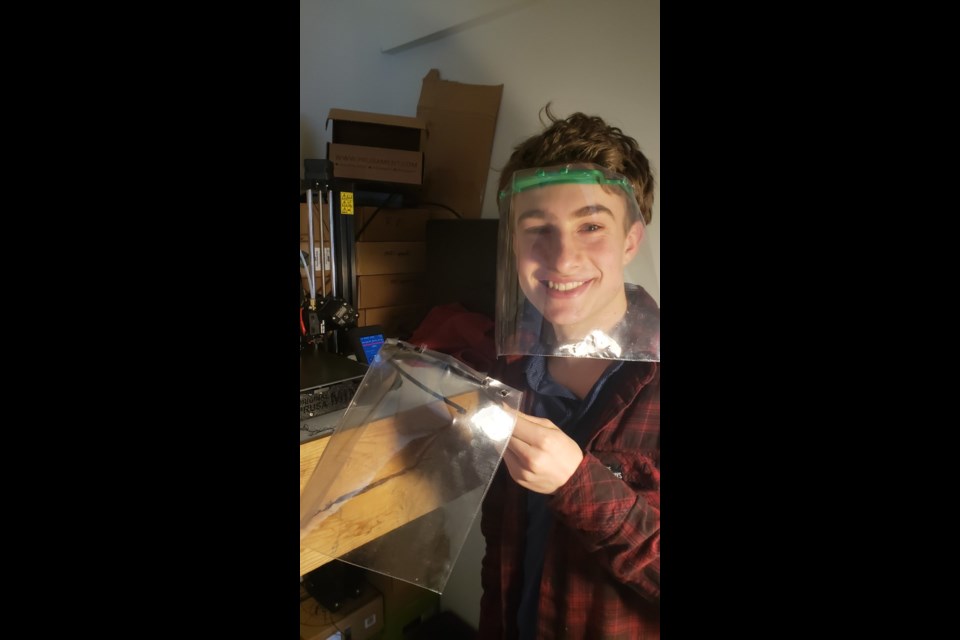CANMORE – It started as a simple hobby.
When local Canmorite Paul Fearing purchased his first 3D printer back in 2014, he had no idea he would one day be using it to print face shields for frontline workers as the world battles a new coronavirus pandemic.
As public gatherings remain at a maximum of 15 people, non-essential businesses shutter their storefronts and Albertans physically distance at least two metres in public – all in an effort to keep the number of positive cases low to not overwhelm hospitals and health services – Fearing found a way to help, all while respecting the new health guidelines.
“I felt like I should do something [and] I started grinding out face shields – I tried several different designs to figure out what works for us,” Fearing said.
With a PhD in computer science, Fearing has been working with his 14-year-old son Colin to print about 166 masks over the last couple of weeks.
“It’s been rewarding and it’s been a fun thing to do with my kid,” he said.
“The thing that is neat about 3D printing right now, it is something your average hobbyist in their basement can do to help out.”
But Fearing does not want all the credit, as other locals have stepped up to try their hand at 3D printing to also help frontline and essential workers.
It was a conversation with Canmore Collegiate High School (CCHS) teacher Ken Symington that got the Fearing family on the 3D face shields printing train.
Symington and Fearing met about a year ago, after Fearing spearheaded the inaugural Mountain Makers Madness, hosted at Lawrence Grassi Middle School. As a father of a future CCHS student, Fearing liked the idea of creating a space where the next generation could create and not just consume in a school setting. Makers Space, a complimentary course in the high school similar to mechanics, shop or drama, was born.
Launched last fall, it was in full swing before schools across the province and country shut down, asking students to stay home to prevent the spread and flatten the curve.
Some teachers were still asked to work from the empty school and Symington was asked if he could use the 3D printers from the Makers Space program to print ear savers.
“A colleague of mine knows a nurse from the Banff hospital, and [the nurse] heard about these ear savers, because she wears her mask and knew it was tight, she asked if I could print these,” he said.
Symington said the ear savers require a simple code and takes approximately 31 minutes to print. Using non-office hours, Symington has been able to print more than 100 ear savers in the last couple of weeks and said he continues to print new batches every day.
“At the same time I started, Paul got in touch with me … he was asking about how to help and I had tried to print face shields, but it was a big mess,” Symington said with a laugh.
While the code for the ear savers was somewhat simple, the code for the face shields was more complex and knowing Fearing’s background in computer science, Symington said if he wanted to assist, printing face shields could be a big help.
At the same time Symington and Fearing were collaborating on printing supplies, conversations were happening in the Canmore fire hall between firefighters on how they could also further help the current situation.
“A group at the fire hall was looking out and seeing we had all this community support as firefighters and health care works, but we thought, what can we do to give back,”said local firefighter Todd Sikorsky.
Hearing other stories of 3D printing, the firefighters thought if 13 year olds could print supplies for frontline and essential workers, so could they. The group pooled some money together and purchased a $1,400 3D printer.
“There weren’t any local resources that I knew of at the time … so we bought the printer and I learned how to use it,” Sikorsky said.
Sikorsky said despite having some background in computer programming, it was still a learning curve to print ear savers and bias tape makers, which help with assembling face shields. When he heard about Fearing and Symington's efforts, he reached out for advice.
“Todd called and asked us a lot of 3D printing questions,” Fearing said.
It worked out for the best, as Fearing and Symington were also trying to organize how to distribute the supplies, as Sikorsky knew contacts across southern Alberta.
Since the three have collaborated, hundreds of ear savers, face shields, and bias tape makers have gone to the Canmore General Hospital, Banff Mineral Springs Hospital, the Calgary Fire Department, Alberta Health Service and Nakoda Emergency Services.
“Everyone is really grateful,” Sikorsky said.
Fearing also wanted to give a shoutout to the Makers Group, who he said would be helping if they had access to the printers.
“If the CCHS kids were in school, they’d be all over this project since we were learning/teaching 3D printing when the shutdown occurred,” Fearing said.
But all locals are just happy to help.
“I just feel incredibly honoured and fortunate to be able to be working in the school and doing it on the side as I teach,” Symington said.
“Teaching classes online and doing this on the side, I am just happy I can contribute in any way. I know one nurse was very thrilled to have them and very grateful.
"I am just very pleased I can do something in this time.”
If any essential or frontline workers are looking for supplies, get in touch with Sikorsky through the Canmore Fire Fighters Association Facebook page.
Follow RMOToday.com's COVID-19 special section for the latest local and national news on the coronavirus pandemic, as well as resources, FAQs and more.




